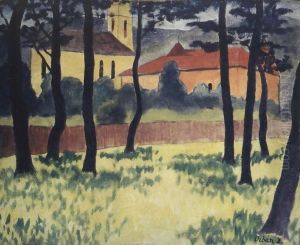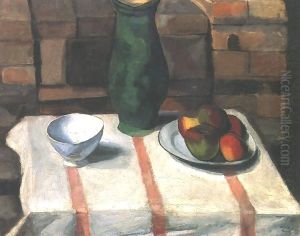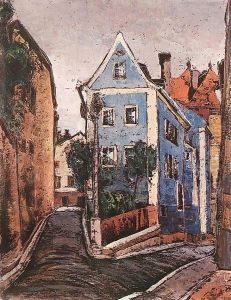Miksa Roth Paintings
Miksa Roth was a Hungarian artist born on December 26, 1865, in Pest, which later became part of Budapest, Hungary. He is celebrated for his work in stained glass and mosaics, making a significant contribution to the Art Nouveau movement in Hungary at the turn of the 20th century. Roth's father, Zsigmond Roth, was also a glass painter, providing Miksa with an early introduction to the craft. After studying in Munich, where he was influenced by the burgeoning Jugendstil movement, Roth traveled extensively in Italy and France, further refining his skills and aesthetic sensibilities. Upon returning to Hungary, he took over his father's workshop in 1885, marking the beginning of a prolific and influential career.
Roth's work combined traditional craftsmanship with innovative techniques and materials, often incorporating elements of Hungarian folklore and motifs into his designs. His contributions to the field were recognized early on; he won a silver medal at the 1896 Millennium Exhibition in Budapest, which celebrated a thousand years of Hungarian statehood. Roth's acclaim continued to grow as he worked on numerous public and private commissions across Hungary and abroad. Notable projects include the stained glass windows for the Hungarian Parliament Building, the Gresham Palace (now the Four Seasons Hotel) in Budapest, and the Elisabeth Bridge.
Roth was also an early adopter of the opalescent and favrile glass developed by Louis Comfort Tiffany in the United States, further evidence of his innovative approach to the medium. His work in the early 20th century is characterized by a dynamic integration of natural forms and geometric patterns, embodying the spirit of the Art Nouveau and later the Art Deco movements.
Despite the challenges posed by the two World Wars and changing artistic trends, Roth continued to work until his death on June 14, 1944, in Budapest. His legacy is preserved through his magnificent works found in buildings throughout Hungary and in the Miksa Roth Memorial Museum, which was established in his former home and workshop in Budapest. The museum houses a comprehensive collection of his works, including stained glass panels, mosaics, and preparatory sketches, offering insight into the artist's creative process and the historical context of his work. Miksa Roth remains a towering figure in the history of Hungarian decorative arts, celebrated for his mastery of color, light, and form.


